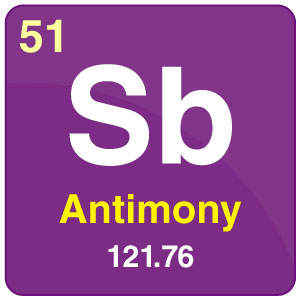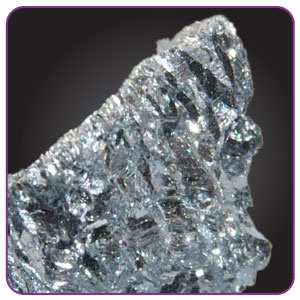
| Symbol | Sb |
| Atomic Number | 51 |
| Atomic Mass | 121.760 g.mol -1 |
| Discovery | approx 1600 BC |

Table of Contents
- What is Antimony?
- Properties of Antimony
- Chemical Properties of Antimony
- Uses of Antimony
- Certain Health Facts About Antimony
- Recommended Videos
- Frequently Asked Questions – FAQs
Chemical Properties of Antimony
| Group | 15 | Melting point | 630.628°C, 1167.13°F, 903.778 K |
| Period | 5 | Boiling point | 1587°C, 2889°F, 1860 K |
| Block | p | Density (g cm−3) | 6.68 |
| Atomic number | 51 | Relative atomic mass | 121.76 |
| State at 20°C | Solid | Key isotopes | 7Sb |
| Electron configuration | [Kr]4d10 5s2 5p3 | CAS number | 7440-36-0 |
| ChemSpider ID | 4510681 | ChemSpider is a free chemical structure database. | |
What is Antimony?
- Antimony is a semi-metallic chemical element with an atomic number 51 and symbol Sb in the Periodic Table.
- The Latin name of Antimony is Stibium. It is generally found in two forms namely metallic form and non-metallic form.
- Antimony compounds are used since ancient times as a component in cosmetics.
- It is naturally found in Earth’s crust in the ores of valentinite and stibnite.
Uses of Antimony
- Pure antimony is used in the manufacturing of certain semiconductors like infrared detectors and diodes.
- It is used to harden lead and increase its durability.
- Batteries consist of antimony for smooth functioning.
- It is also used to make small arms & bullets.
- It is a very good flame retardant
Properties of Antimony
- The metallic form appears in a bright silver colour brittle and non-metallic form will appear as the grey powder.
- It is a weak conductor of electricity and heat. The special feature of antimony and its alloys is that they expand on cooling.
Certain Health Facts About Antimony
- It is toxic but does not have any harmful effects.
- But constant exposure to this may cause some diseases like lung diseases, heart problems, and stomach ulcers.
- Harmful effects of antimony upon body tissues and functions can occur following inhalation or ingestion of certain compounds of antimony. Such poisoning resembles arsenic poisoning.
- Antimony poisoning has resulted from drinking acidic fruit juices containing antimony oxide dissolved from the glaze of enamelware containers.
- The major toxic side effects of antimony as a result of therapy are cardiotoxicity and pancreatitis which is seen commonly in HIV and visceral leishmaniasis coinfections.
Recommended Videos

Frequently Asked Questions – FAQs
What is antimony used for?
Batteries are made of a lead-antimony alloy. Antimony alloys are also used in type metal (for printing presses), bullets, and cable sheathing. Flame-retardant materials, paints, enamels, glass, and pottery all include antimony compounds. Antimony and several of its derivatives are poisonous.
Is antimony harmful to humans?
Antimony poisoning can arise as a result of occupational exposure or as a side effect of treatment. Respiratory irritation, pneumoconiosis, antimony spots on the skin, and gastrointestinal complaints are all possible side effects of occupational exposure. Furthermore, antimony trioxide may cause cancer in humans.
Why is it called antimony?
Antimony is derived from the Greek words anti and monos, which imply “not found alone.” The element’s historical name, stibium, inspired the chemical symbol Sb.
How does antimony get into the body?
Antimony can enter your body through water, food, soil, or other antimony-containing things. Antimony can also enter your body if you breathe antimony-contaminated air or dust.
Where is antimony found in nature?
Although few native antimony resources have been discovered, the majority of antimony is found in the form of over 100 distinct minerals. Stibnite (Sb2S3) is the most important of them. Algeria, Bolivia, China, Mexico, Peru, South Africa, and areas of the Balkan Peninsula have small stibnite deposits.

Who discovered Antimony?
The discovery of antimony is credited to Arabic alchemists before 800 AD